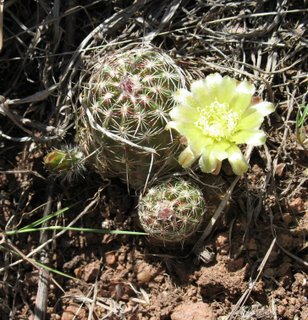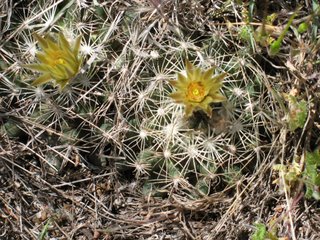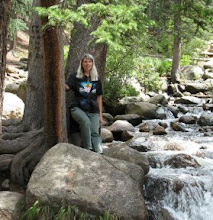Besides the abundant prickly pear, the foothills offer these two ground-hugging cacti. They can be tricky to tell apart, so let’s take a closer look.
 Most common is the “hen and chickens” or “green pitaya,” Echinocereus viridiflorus. (The species name means green-flowered.) It is more likely to grow tall (maybe 4-6 inches) and cylindrical than the second one shown here, and the spines tend to congregate on vertical ridges.
Most common is the “hen and chickens” or “green pitaya,” Echinocereus viridiflorus. (The species name means green-flowered.) It is more likely to grow tall (maybe 4-6 inches) and cylindrical than the second one shown here, and the spines tend to congregate on vertical ridges. Flowers are just over an inch in diameter, to give you a sense of scale here.
 Less often seen, in part because it can be so cryptic, is the nipple cactus, Coryphantha missouriensis. Short and compact, it actually withdraws into the ground a bit during the winter, making it even harder to spot. When in bloom, though, its yellowish flowers give it a little more distinction. The spines occur at the tips of protuberances, hence the name “nipple” cactus. In recognition of this feature, the genus was originally called Mammillaria. A similar species (C. vivipara) has pink flowers and is more unusual in our area.
Less often seen, in part because it can be so cryptic, is the nipple cactus, Coryphantha missouriensis. Short and compact, it actually withdraws into the ground a bit during the winter, making it even harder to spot. When in bloom, though, its yellowish flowers give it a little more distinction. The spines occur at the tips of protuberances, hence the name “nipple” cactus. In recognition of this feature, the genus was originally called Mammillaria. A similar species (C. vivipara) has pink flowers and is more unusual in our area.

No comments:
Post a Comment